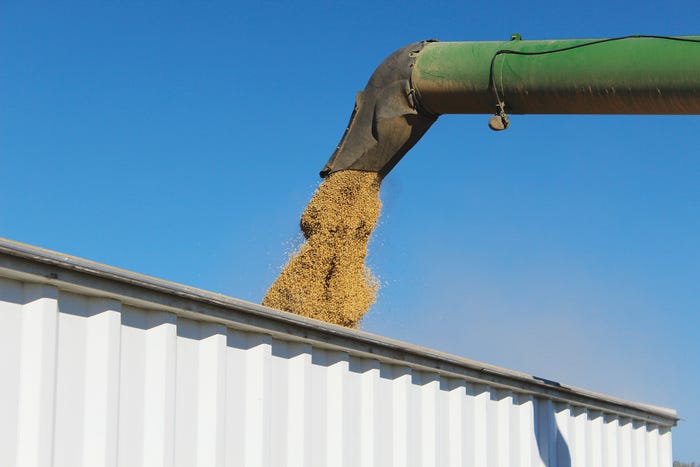
As soybean producers across the Mid-South look to the 2017 planting season, the first important decision they will make is seed selection. Some of the region’s most respected Extension specialists have provided information related to key aspects of soybean production.
Seed, Fertility, And Planting
“When I give variety selection advice,” says Jeremy Ross, Extension soybean agronomist at the University of Arkansas, Division of Agriculture, “I ask which herbicide program will be used, the soil texture of the fields, are there any disease or nematode problems, and are there high chlorides in the fields? I want to make sure my advice takes at least those aspects into consideration.”
Planting a variety in the wrong environment will limit its potential to maximize yield. State soybean trial research findings provide insight into a broad range of varieties, but always look for a variety with good yield stability across environment types.
“I advise growers with large soybean acreage to plant varieties with differing maturities so harvest can be staggered, quality can be preserved, and crop degradation potential lowered,” says Ronnie Levy, state soybean specialist for Louisiana’s LSU Ag Center.

The raceme, or flowering structure of a soybean, ushers in pod set and seed growth as the plant develops.
A soil pH level of 6.3 to 6.5 is optimum for soybeans. Soil tests should be pulled every three years to monitor fertility levels. Soybeans use macronutrients in high quantities, especially potash, so look at what you removed from your soil last year and make input adjustments so the nutrient demands of the crop are provided. Remember, soybeans respond to fertilization, and yields can be limited if adequate fertility is not available.Soybeans planted early (April to mid-May) typically out-yield those planted late, because they need sunlight to produce food, and early canopy closure will help capture maximum daylight.
“Soybeans will respire in hot nighttime temperatures, using photosynthates (sugars) made during the day to stay cooler at night. During that process, carbon captured during photosynthesis is lost back to the atmosphere as these sugars are cannibalized,” Levy says.
Once the plant canopy closes, preventing the sun from warming the soil, weed competition will be reduced and soybeans will also benefit from cooler soils and less water lost to evaporation.
Seeding Rates
Seed is among the producer’s highest direct costs, and the optimum agronomic seeding rate is always higher than the optimum economic seeding rate when comparing soybean market values against seed costs.
“Over many years, research has shown a good per acre seeding rate range is 100,000 to 180,000,” says Jeremy Ross. “Many of the producers with whom I work are in the middle of this range. But if someone plants on the extremes of the planting window (very early or very late), we recommend increasing the seeding rate by 10 percent to 15 percent to insure adequate plant stands.”
There are advantages and disadvantages for low and high seeding rates. Higher rates limit a plant’s ability to branch out, and rates too low don’t optimize yield potential.
“One acre has 43,560 square feet of soil,” says Ronnie Levy, “so if you have a 120,000 per acre seeding rate, that would be 3 plants per square foot. At 2 plants per square foot, you’d have 75,000 to 80,000 seeds per acre. Always consider the environment and planting date, and be conservative with seeding rates. Extreme plant populations can lead to lodging, increased disease, and other yield-reducing problems.”
Ross always reminds producers that they may not see benefits from seed treatments every year, but in years of adverse weather, seed treatments can protect young soybeans from disease and help maintain strong stands.
A timing study conducted by Ross on inoculants showed they provide significant yield increases at later planting dates. Because of the symbiotic relationship between soybeans and the soil, inoculants promote the conversion of nitrogen from the atmosphere to the plant.
“We’re in the third year of this study,” he says, “but we’ve seen a 5 bushel to 12 bushel increase when using inoculants after a mid-June planting date. Inoculant seed treatments seem to be more effective than inoculants dispersed through hopper boxes.”
No-Till And Irrigation
Although some farmers will always plow, more and more are starting to capitalize on the benefits of no-till soybeans. A good soil profile is the foundation for nutrient transfer to the plants and subsequent plant health.
“Any of the forms of conservation tillage provide benefits to soil structure,” Levy says. “As organic matter decays, all the little root hairs form channels for moisture to move down into the soil. It improves soil health and builds the soil profile.”

Seeing the combine’s auger arm transferring high soybean yields to the grain cart or the hopper bottom truck verifies a producer made the right decisions throughout the crop year.
No-till provides an additional benefit from rain events in dry years because soils with higher organic matter retain more water, providing the crop moisture for longer periods. “Soil structure is hard to explain,” Levy says, “but think about building blocks arranged to allow water to move through and carry nutrients to roots. That’s exactly what conservation tillage does.”As weather patterns continue to change, reliable supplemental irrigation improves yields. While the Delta enjoys widespread water availability, today’s irrigation scheduling technologies and subsurface moisture sensors relay soil conditions to smart phones and tablets, which can be used to activate irrigation systems.
“I see instances where producers over-irrigate, especially toward season’s end,” Levy says. “Irrigation is an art, and it’s difficult to gauge visually. You’ve got to know soil moisture levels, and a moisture evaluation system will increase efficiency and save money.”
Producers make hundreds of decisions each year, and now is time to make the first one: seed choice.
About the Author(s)
You May Also Like




